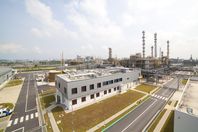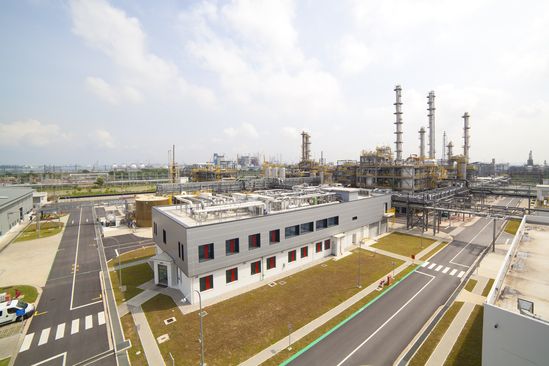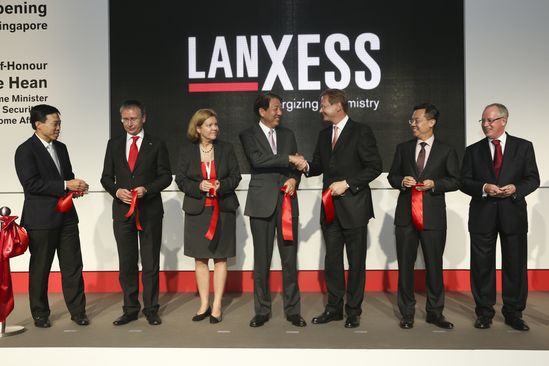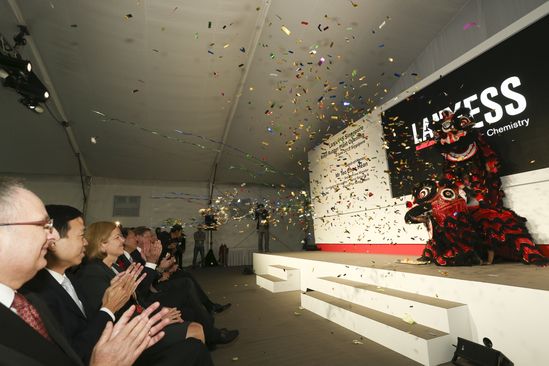Asia
EMEA

LANXESS Canada Contacts
Contact our Sites in Canada
Media Inquiries
General Inquiries
Please click here to e-mail LANXESS Canada with product inquiries and general requests.
Global Press Releases
2013-06-04
LANXESS opens Asia’s most modern butyl rubber plant in Singapore
- Capacity of 100,000 metric tons per year
- Production of high-quality halobutyl rubber
- LANXESS’ biggest investment ever at EUR 400 million
- 160 highly qualified new jobs created
- Opening ceremony on Jurong Island
At an official ceremony attended by around 400 guests, LANXESS inaugurated its new butyl rubber plant on Jurong Island in Singapore on schedule. The specialty chemicals company has invested approximately EUR 400 million in the plant, which will have a capacity of 100,000 metric tons. The plant will create about 160 highly qualified new jobs that will mainly be filled locally. The facility is the most modern of its kind in Asia and will produce premium halobutyl rubber, as well as regular butyl rubber.
LANXESS is the first butyl rubber manufacturer to have a wholly-owned global presence. The newly opened plant in Singapore joins existing butyl rubber plants in Sarnia, Canada, and Zwijndrecht, Belgium. This means that the specialty chemicals company now has state-of-the-art facilities on three continents. The butyl rubber facility in Singapore went into operation in the first quarter of 2013 and is being ramped up gradually. Commercial production will start in the third quarter of this year. The facility is expected to achieve full capacity in 2015.
“This is the largest investment in the company’s history, and underlines the importance of Asia as a location for our synthetic rubber business,” said Axel C. Heitmann, LANXESS’ Chairman of the Board of Management during the opening ceremony. “We have clearly built this plant with the future of mobility in mind because we think and act long-term.”
Also present at the event were Teo Chee Hean, Deputy Prime Minister of Singapore, Angelika Viets, the Ambassador of the Federal Republic of Germany to Singapore, and Ron Commander, Head of the LANXESS Butyl Rubber business unit.
"Riding the growth trend in Asia, LANXESS is using Singapore as their base to grow their Pan-Asian business. With companies further expanding their activities in Singapore to include headquarter and R&D activities, we expect a wide range of enriching career opportunities for many Singaporeans in the chemicals sector. I would like to extend my heartfelt congratulations to LANXESS on the opening of its first butyl rubber facility in Asia, and look forward to many more years of fruitful partnership," said Teo Chee Hean.
Megatrend Mobility
The butyl rubber market is expected to grow on average by 5 percent in the coming years, with the main driving force being the megatrend mobility, above all in Asia. The tire industry accounts for around three-quarters of sales at LANXESS’ butyl rubber business unit and more than 50 percent of sales is generated in Asia.
For example, passenger cars in China and India alone are expected to more than triple within the next 15 years, mainly due to a growing middle-class there. In addition, there is a clear trend towards the use of radial or tubeless tires for buses and trucks in India and China, which is changing the face of commercial mobility. Modern radial tires require an inner liner made of halobutyl rubber, which helps keep tire pressure constant for longer because of its impermeability to gases, thus saving fuel and reducing CO2 emissions.
“With our high-tech products, we are a leader in enabling ‘Green Mobility’,” said Heitmann.
A new application for bromobutyl rubber, a type of halobutyl, is in the tread of tires. It enhances the characteristics of tires by improving both grip and the associated wet braking performance without compromising rolling resistance.
Another use for halobutyl rubber is in pharmaceutical closures. This special-purpose rubber is even required by law in some Asian countries, for example China. Some of the world’s biggest pharmaceutical closure manufacturers are to be found in Asia. Pharmaceuticals account for some 10 percent of LANXESS butyl business.
Other applications for butyl rubber are protective clothing, shoe soles, adhesives and chewing gum. Its impermeability to gas and resistance to chemicals has also proven valuable in vehicle air conditioning systems and tank linings.
Highly complex production process
The manufacture of butyl rubber is highly complex and involves process steps at temperatures ranging from minus 100 to plus 200 degrees Celsius. The current production process used for butyl rubber has been upgraded and has been implemented in Singapore.
Around 10 percent of the total investment has gone toward technologies that make the butyl rubber plant more environmentally friendly. For example, significantly less steam is used in the manufacturing process than in comparable facilities, leading to lower energy consumption. Chemical compounds from the production process are treated in state-of-the-art thermal off gas units, so that the environment is not affected.
“This process is evidence of our global leadership in rubber manufacturing. I am very proud that we are setting new standards in the industry,” said Ron Commander, Head of the Butyl Rubber business unit.
Ideal conditions in Singapore
The butyl rubber facility was engineered and constructed by Foster Wheeler Asia Pacific Pte. Ltd. on a 150,000 square-meter plot on Singapore’s Jurong Island. The premises have been leased from the JTC Corporation, a Statutory Board under the Singapore Ministry of Trade and Industry.
Jurong Island is located off the coast of the city-state and offers an infrastructure geared specifically to the needs of the chemical industry, thus providing ideal conditions for LANXESS. For example, the company has secured the long-term supply of isobutene, an important raw material for butyl rubber production, from a neighboring plant.
LANXESS also started construction of a new production facility for neodymium-based performance butadiene rubber (Nd-PBR) on Jurong Island last year. The direct proximity of these two plants creates valuable synergies for the company, for example through joint infrastructure and logistics.
LANXESS currently employs around 380 people in Singapore, which is an important hub for the company in Southeast Asia and the Asia-Pacific region. Singapore has been home to the global headquarters of the Butyl Rubber business unit since 2010.
The Butyl Rubber business unit is part of LANXESS’ Performance Polymers segment, which recorded sales of EUR 5.2 billion in 2012.
LANXESS is a leading specialty chemicals company with sales of EUR 9.1 billion in 2012 and roughly 17,400 employees in 31 countries. The company is currently represented at 50 production sites worldwide. The core business of LANXESS is the development, manufacturing and marketing of plastics, rubber, intermediates and specialty chemicals. LANXESS is a member of the leading sustainability indices Dow Jones Sustainability Index (DJSI) World and FTSE4Good as well as the Carbon Disclosure Leadership Index (CDLI).
- Gallery









